When it comes to paid advertising options for B2B, LinkedIn Ads is frequently the first that comes to mind. The platform offers a unique opportunity to capture prospects while they are in “work mode” instead of running the risk of interrupting their personal time. As a result, the platform often performs better when it comes to KPIs like click-through rate and cost per lead.
This guide fully breaks down the key LinkedIn Ads offerings for B2B companies, what kind of content performs best on the platform and how much you can expect to pay.
It’s also very easy to drain a tremendous amount of budget on poorly-executed LinkedIn Ads campaigns. I’ll be telling you the key pitfalls your business should avoid if you want to maximise that tasty ROI.
Overall, I’ll be answering the question “Is LinkedIn Ads worth it?” - so read on if you are a CMO, marketing, commercial or programme director looking to weigh up the pros and cons of the platform…
It’s a long one, so here are some chapters:
- Why LinkedIn Ads?
- Best LinkedIn Ad campaign types for B2B:
- What sort of content should you push on LinkedIn ads?
- How much are LinkedIn Ads?
- Mistakes that will drain your budget
- Shortcomings of LinkedIn Ads
- Is LinkedIn Ads worth it?
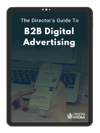 Free Download: The Director's Guide to B2B Digital Advertising
Free Download: The Director's Guide to B2B Digital Advertising
Get an overview of the key paid advertising options on channels like LinkedIn Ads and Google. Includes average costs, KPIs plus an example LinkedIn Ads campaign. Download Now.
Why LinkedIn Ads?
There are a wealth of advertising options available to businesses today including Google search ads, Facebook ads and inventory from online publishers in your niche. So what makes LinkedIn Ads so special?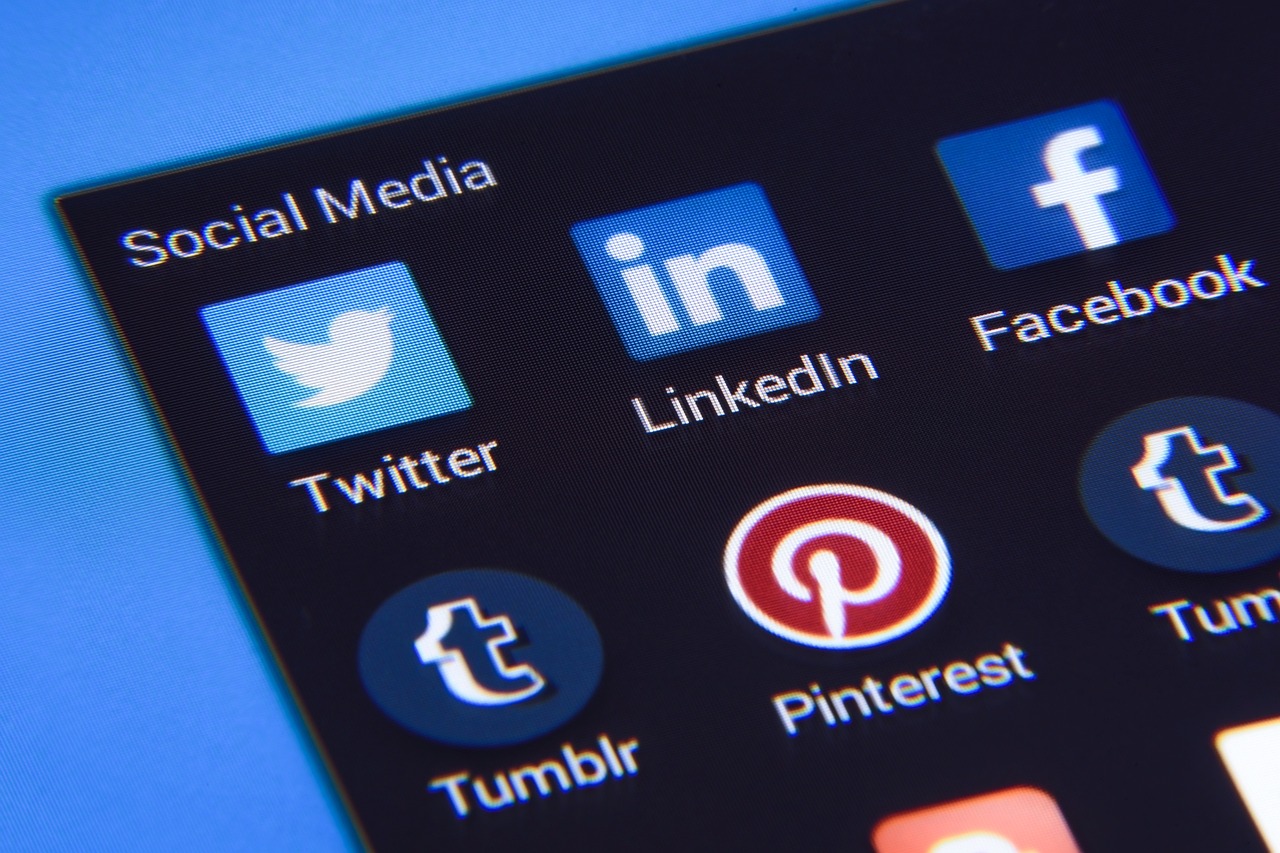
There are a couple of clear USPs, especially in the context of B2B advertising:
- Targeting: The work-related demographic targeting at your fingertips on LinkedIn is unmatched by any other platform. You can refine your targeting to specific job titles, company names, years of experience, seniority and more. Combining this with other forms of targeting like list match and retargeting makes for a very powerful tool in your marketing arsenal, but there are some limitations and shortcomings. I’ll go into these later.
- Context: It’s no secret that successful ads must appear in the right place at the right time to the right target. Advertising on LinkedIn means your ad will fulfill the first two prerequisites by default, at least to some extent. LinkedIn is a platform for business, so the chances of your ad appearing at a time when your target is trying to not think about their business challenges is much lower than, say, Facebook (which often is used during personal time).
- Immersion: With LinkedIn lead gen forms your prospects can download your lead magnet without having to leave the LinkedIn platform. Additionally, all or at least most of their demographic data is pre-populated on the native lead gen form. This means less effort on the part of your prospect, and as a result the conversion rate of these campaigns is very decent. According to The B2B House, any form completion rate above 10% is considered good, but I’ve run many campaigns where this is more like 35% - 40%.
Of course the impact of these USPs on your results will vary depending on the type of campaign you choose. Let’s breakdown three formats that your business could leverage to generate touchpoints, leads and engagement with prospects during different stages of the buying journey.
Best LinkedIn ad campaign types for B2B
LinkedIn Ads’ inventory has increased somewhat since the platform was launched in 2005. Below are some available campaign types I think work particularly well for industries like SaaS and technology, although of course they can be applied to most sectors.
Lead generation forms
1st party data is becoming increasingly important, especially with the tightening of GDPR legislation and Google’s proposed sunsetting of 3rd party cookies. So for B2B organisations acquiring this data through an interface that allows you to display GDPR text and link to a privacy policy is a plus. Add to this pre-populated fields and the ability to convert without leaving the LinkedIn platform - this is Lead Generation Forms.
Creating the form itself couldn’t be easier and as well as core LinkedIn data like email, company name, job title etc, you can use custom fields to ask pertinent questions that will help score the lead. You can also use hidden fields to capture any tracking information and custom checkboxes to collect contact consent. Once you’re happy, you simply save the form and it will be ready to use in an ad campaign of your choosing.
💡Top tip
You cannot edit fields, custom questions, checkboxes etc once you have saved the form. So triple check you are happy with these. The form headline, details and privacy policy text can be edited later on.
Lead Generation forms are compatible with the following ad formats.
- Single image ad: Shows up in the news feed as a single image with your ad copy.
- Carousel image ad:

- Video ad: Shows up in the news feed (for lead generation ads I suggest making this short and sweet).
Message ads were discontinued in May 2023 and conversation ads (also known as Sponsored Messages) have been discontinued in the EU.
However, LinkedIn added a new ad format in late 2022 which businesses can leverage for a variety of purposes, including displaying a multi-page preview of a resource or measuring engagement metrics with an audience further on in the buying journey.
Document ads
Although technically an ad format rather than a campaign type, the robust reporting available for tracking engagement makes document ads a real asset to your digital advertising strategy.
By going to your campaign manager dashboard and selecting “Documents” from the columns menu, you get access to your bog-standard KPIs (impressions, clicks, CTR etc) PLUS the following more granular metrics:
- Preview download clicks
- Download clicks
- Viral download clicks
- Viral preview download clicks
- Displays @ 25%
- Displays @ 50%
- Display @ 75%
- Completions
- Viral Displays @ 25%
- Viral Displays @ 50%
- Viral Displays @ 75%
- Viral Completions
Note that here “Viral” simply means these results were acquired from a user sharing your document ad with their network and “Displays” are the percentage of preview pages the user viewed. “Completions” means the user viewed 100% of your preview-able pages.
These reporting metrics means document ads have a number of possible applications:
- Lead generation: Rather than a creative image to illustrate your ad, you can give users a glimpse of your resource (as many pages as you like) before they commit to downloading. This level of flexibility is handy for longer-form resources, especially if there is a table of contents users can easily view.
- Brand awareness / thought leadership: If you’re looking to create waves and get a longer-form piece of content in front of your desired audience without them needing to leave LinkedIn, document ads could be right for you. Staying on the LinkedIn platform minimises disruption to the user and makes them more inclined to view the final content. When you set your campaign objective as Brand Awareness, document ads allow users to view all the pages of your thought-leadership piece without the obligation to download it. You can then use performance metrics like displays, completions and viral completions to understand how much of an impact your piece is having.
💡Top tip
Ensure that your targeting is finely tuned for brand awareness campaigns and utilise the exclusion filters to explicitly sift out any anti-personas. You can easily waste a lot of budget broadcasting your thought-leadership piece to the wrong users.
- Nurturing for later-stage prospects: Through list match targeting you can export contacts from your CRM who have already enquired about your product and target them with a longer-form document to provide a touchpoint and move them further down the funnel. For example, if you are using Hubspot CRM, you could export all contacts associated with a business that has a deal in the deal lifecycle stage “Prospecting” or later. You upload this list to LinkedIn and launch a document ads campaign that allows users to view the entirety of your document. Or perhaps you would like to become aware of specific contacts who are really receptive, so you could make the last page of your preview into a CTA to encourage them to convert. This might be for example “Click ‘Unlock full document’ to learn how {CLIENT NAME} achieved a 300% ROI with {YOUR SERVICE}”.
- Experimentation and understanding your audience: The ability to run campaigns with multiple ad versions means you can play with the page order of certain content pieces, such as case studies or trends reports. Does changing the order of the pages affect the download rate of your campaign? Are users more likely to view the next page? This can help you understand what is resonating with your audience and what hooks work best to engage them.
So yes, all in all, I am a fan of document ads.
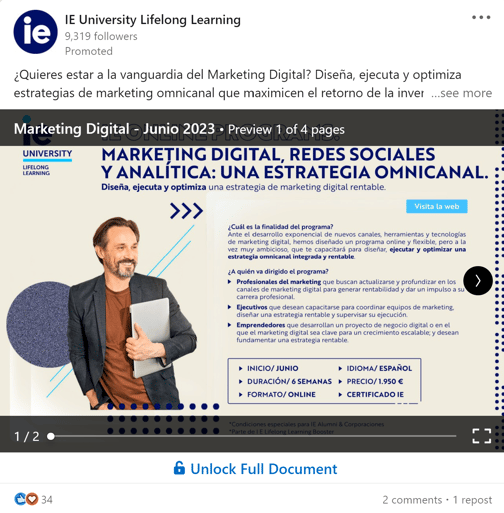 That said, they do have some slight pain points. For example, the inability to edit a saved document ad and not being able to use a CTA button outside of the “Unlock full document” one when used with lead gen forms. So, for example, you couldn’t offer a full preview of all your document pages, and have “Request a Demo” as a CTA button with it linking to your website. Hopefully LinkedIn will continue to launch updates to this format that allows for more flexibility on this.
That said, they do have some slight pain points. For example, the inability to edit a saved document ad and not being able to use a CTA button outside of the “Unlock full document” one when used with lead gen forms. So, for example, you couldn’t offer a full preview of all your document pages, and have “Request a Demo” as a CTA button with it linking to your website. Hopefully LinkedIn will continue to launch updates to this format that allows for more flexibility on this.
Retargeting with video ads
When it comes to retargeting prospects or site users, it’s no secret that video is one of the most powerful formats of choice. And the good news is that LinkedIn has a number of ways you can add video touchpoints to the buying journey.
- LinkedIn Pixel on your website: This means you can retarget LinkedIn users who have previously visited your website. You can create different audiences depending on the page they have visited.
- Company page followers: With the massive amount of content appearing on your followers’ feeds it’s easy to get lost in the crowd when posting organically. Retargeting the followers of your company page can be a way to combat this.
- Engagement with lead gen forms: Retarget users who clicked on your lead gen ads but didn’t complete the form.
What type of video content you retarget users with really depends on your objectives and their stage in the buying journey. Testimonial videos are a firm favourite among SaaS businesses but may be too much for someone who has only visited your website once or twice. The previously accepted statistic of 7 marketing touchpoints before a B2B purchase is highly debatable, especially for businesses with a high average order value. So think carefully about the action you really want your prospects to take next based on where they are psychologically at that exact moment.
Above: Testimonial videos don’t have to be fancy - this one from Chili Piper keeps production values simple and focuses on results.
What sort of content should you push on LinkedIn Ads?
As stated above this depends on your objective and your audiences but in theory a wide variety of content types could be leveraged with LinkedIn ads.
Here are some examples with the targeting and ad formats you might use (but please note this isn’t a rulebook):
White papers / eBooks
Audience: Discovery, awareness, Top-of-funnel (TOFU)Ad format: Single image ad with lead gen form
Case studies
Audience: Consideration, middle-of-funnel (MOFU)Ad format: Document ad with 2 or 3 preview pages and lead gen form to unlock the full document.
Short-form educational video ads
Audience: Awareness, TOFUAd format: Video ads targeting company page followers.
Trends / state of the industry reports
Audience: TOFU / MOFUAd format: Carousel ad displaying key headlines with lead gen form.
Webinars
Audience: MOFUAd format: Sponsored content with link to landing page on your website.
Buying guides
Audience: Evaluation, bottom-of-funnel (BOFU)Ad format: Document ad, fully unlocked.
Technical guides (e.g. security, implementation)
Audience: Evaluation, bottom-of-funnel (BOFU)Ad format: Document ad, mostly unlocked but with incentive to unlock full version (e.g. a step by step of how an existing client implemented your solution).
How much are LinkedIn Ads?
Okay, I’ll get to the point.
LinkedIn Ads are expensive.
In fact, putting any less than $500 behind a campaign will stop you from getting the best out of LinkedIn Ads. I know this because LinkedIn told me themselves at the B2B Marketing Expo a few years ago. They also gave me a free $400 voucher to prove it (and I love a freebie - what a good day that was).
The platform seems especially pricey in comparison to other paid advertising platforms like Facebook Ads, Google Ads or newcomers such as Reddit Ads.
Here are some averages I took from this excellent summary of LinkedIn Ads by The B2B House.
Click-through rate (CTR)
- Single-image ads: 0.56%
- Carousel ads: 0.40%
- Video ads: 0.44%
💡Top tip
Remember that these will vary based on your industry, your location and your audience. According to Itelus, the average CTR globally is between 0.39% and 0.65%.
Cost per click (CPC)
The global CPC for LinkedIn Ads is thought to be $5.58 USD, although this varies depending on demographics like job function. The cost of a click from someone in IT averages at $7.90, whereas a click from someone working in education averages at $5.00.
Cost per acquisition (CPA)
This is what CMOs and commercial directors are most interested in and I’m sorry to say it varies wildly - between $15 to $350.
And again, this depends on a variety of factors. Back to our job function examples, the average CPA of a contact in IT sits at around $125 and at $64 for a contact in Education.
Quality > Quantity
Don’t be dismayed by the averages above. With good targeting practices it’s easy to achieve a high percentage of leads that closely match your ideal customer persona(s).
That said, it’s also very easy to waste money on LinkedIn Ads. I mean A LOT of money.
Here’s some pitfalls to avoid.
Mistakes that will drain your LinkedIn Ads budget
These are easily rectified, but if your business is using LinkedIn Ads for the first time it might be best to hire a digital marketing professional to advise you.
Woolly, vague objectives
“We want the contact to buy our product/service” is not an adequate objective. In the B2B sector, where price points are often far higher than B2C and have a long approval chain, it is simply not realistic to think that someone will go from browsing their LinkedIn feed to purchasing your product, or even requesting a demo, with only an ad to bridge the gap.
Given the target audience and where they’re at in the buying journey - what exact action do you ideally want them to take at this point? Based on this, what metrics should you closely examine during your campaign?
For example, for a document ads campaign showcasing a buying guide targeted at MOFU contacts, an appropriate objective might be “I would like my prospect to browse at least 60% of the guide, and maybe search for our company on Google”.
In this scenario, you should also be closely tracking brand search data on Google Search Console and organic traffic data on Google Analytics, as well as the engagement tracking for the ad campaign on LinkedIn.
A lack of clear objectives also leads to poor decisions on call-to-actions. A generic ad with a link to your website homepage is a great way to waste tremendous amounts of budget and generate no meaningful results.
Remember that your target audience is most likely browsing their feed on LinkedIn, and that engaging with your ad is an interruption to their day. Remove the friction and tell them exactly what they should do next, don’t leave them guessing.
Mediocre Targeting
LinkedIn’s targeting capability is without doubt its standout feature, so don’t throw your budget down the toilet by not utilizing this to its full capacity.
Before your campaign:
- Make sure your business has clear-cut ICPs (ideal customer personas)
- Look at your existing deals and the contacts associated with them - are there any job titles or company sizes that underpinned closed won or later stage deals?
- Talk to your sales folk - what job titles do they engage with most often? Who gets most excited when they see your product? Are there any anti-personas you should exclude from campaign targeting?
When setting up your campaign:
- Start by making your targeting extremely refined (i.e. “perfect” matches) and go from there.
- Leverage inclusion AND exclusion filters.
- Consider cross-segmentation. For example, you could retarget site visitors but only those in director-level positions.
- Personally I always un-tick “Enable Audience Expansion”. As a rule, explicitly stating your target audience drives better results than leaving LinkedIn to find who it thinks your target audience is.

During your campaign:
- Review leads that come in - are they exactly what you want? Are there unexpected job titles being targeted that you need to exclude?
- Talk to sales about lead quality - are these “dream leads” for them? Nothing less than this is worth the CPA on LinkedIn Ads, so be brutal.
- How are these leads responding to being contacted? Are there any patterns emerging?
Uninspired content and copy
With all the resources available regarding best practice for LinkedIn Ads, there’s no excuse for poorly-optimised ad text or generic images.
As a vague guide, your ad text should tell your prospect three things:
- Why they should pay attention to your ad (also known as a hook)
- What value they will get
- What they need to do next
Less is more. Say what you need to concisely. LinkedIn recommends ad headlines of no longer than 150 characters. For reference, this paragraph is 150.
You should experiment with at least 4 ad variations per campaign. As a bare minimum for single image ads, I usually like to have two different versions of the copy and two different images to test.
Get some advice on best practices from the below sources:
LinkedIn Ads shortcomings and limitations
Given its high average price point, you might think that the LinkedIn platform has no disadvantages.
Unfortunately there are a couple of things that you should be aware of.
Personal email addresses
A large number of people register on LinkedIn with their personal email. Although the narrative on personal emails being less valuable than their business counterparts is changing, there are still a couple of reasons why this is a sticking point.
- Auto associations on CRMs: CRMs like Hubspot connect to LinkedIn Ads and import any leads automatically. Many of them also use the email domain of the contact to assign them a company or connect them with an existing company on your database. A contact with a personal email address will not be associated in this way, so you will have to keep track and add this manually if you are using associated company data to score leads.
- Any follow-up or nurturing emails will go to a personal inbox: These are less likely to reach the contact when they are in “work mode” and more receptive, they also may have filters that put your email in the dreaded “other” inbox, or even spam folder.
- Personal emails have lower engagement rates: They also often convert at a lower rate than business email addresses.
That said, personal email addresses are not all bad. In the post-COVID era the line between work and home has been increasingly blurred. Additionally, the second a contact leaves a company their business email address becomes redundant. You can continue to nurture them through personal email even when they are between jobs or at their next role.
💡Top tip
Linkedin lead generation forms has two email field options - “Email” and “Work Email”. If you really want to acquire business emails, you can use the latter option. The “Work Email” field will populate automatically if it detects the user’s registered email is a business address, but the user will have to fill this in manually if they are registered with a personal email. This change will affect your conversion rates and lead quality, so run a test first!
Missing phone numbers
Unlike email, phone number is not a required field when you sign up to LinkedIn - so users will have to enter this manually on lead generation forms. If you make this a compulsory field, your form completion rate will be lower than if all field data was auto-populated.
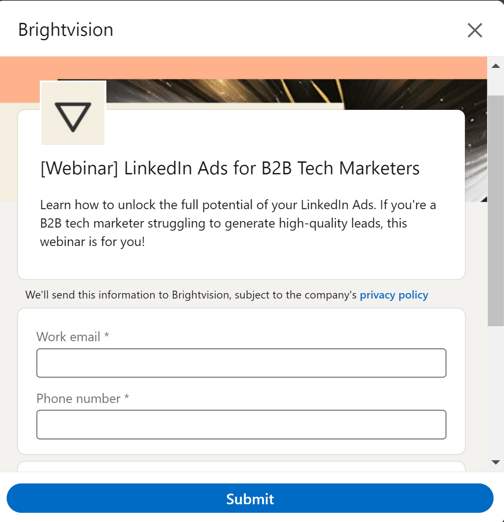 Above: Brightvison has decided to request both a business email address and a phone number to attend their webinar.
Above: Brightvison has decided to request both a business email address and a phone number to attend their webinar.
Contact list minimums
The minimum audience size on LinkedIn Ads is 300 users. Although this is easily achievable with the demographic targeting options, it can be difficult when uploading a list of contacts to be targeted. Match rates can vary, so you may want to upload a list much larger than 300 contacts to ensure it qualifies for targeting.
Is LinkedIn Ads worth it?
The targeting options available, as well as being the largest business social network in the world, makes LinkedIn a good choice for businesses looking to acquire new high-quality leads, nurturing existing prospects and create touchpoints with BOFU-stage prospects.
However, it’s absolutely critical that the objective, content and targeting for the campaign is clear-cut. Blindly throwing money at this platform will be an extremely costly mistake.
If you are a business looking for high-growth, LinkedIn ads can provide amazing results for you. But it’s wise to consult an expert who can advise you on the best way to maximise the budget you have.
With a decade of experience in running LinkedIn Ad campaigns in a variety of industries, I might be the right person to help you. Book a free consultation and let’s see how we can work together to grow your pipeline fast.

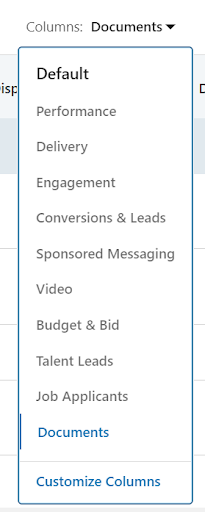
.jpeg)